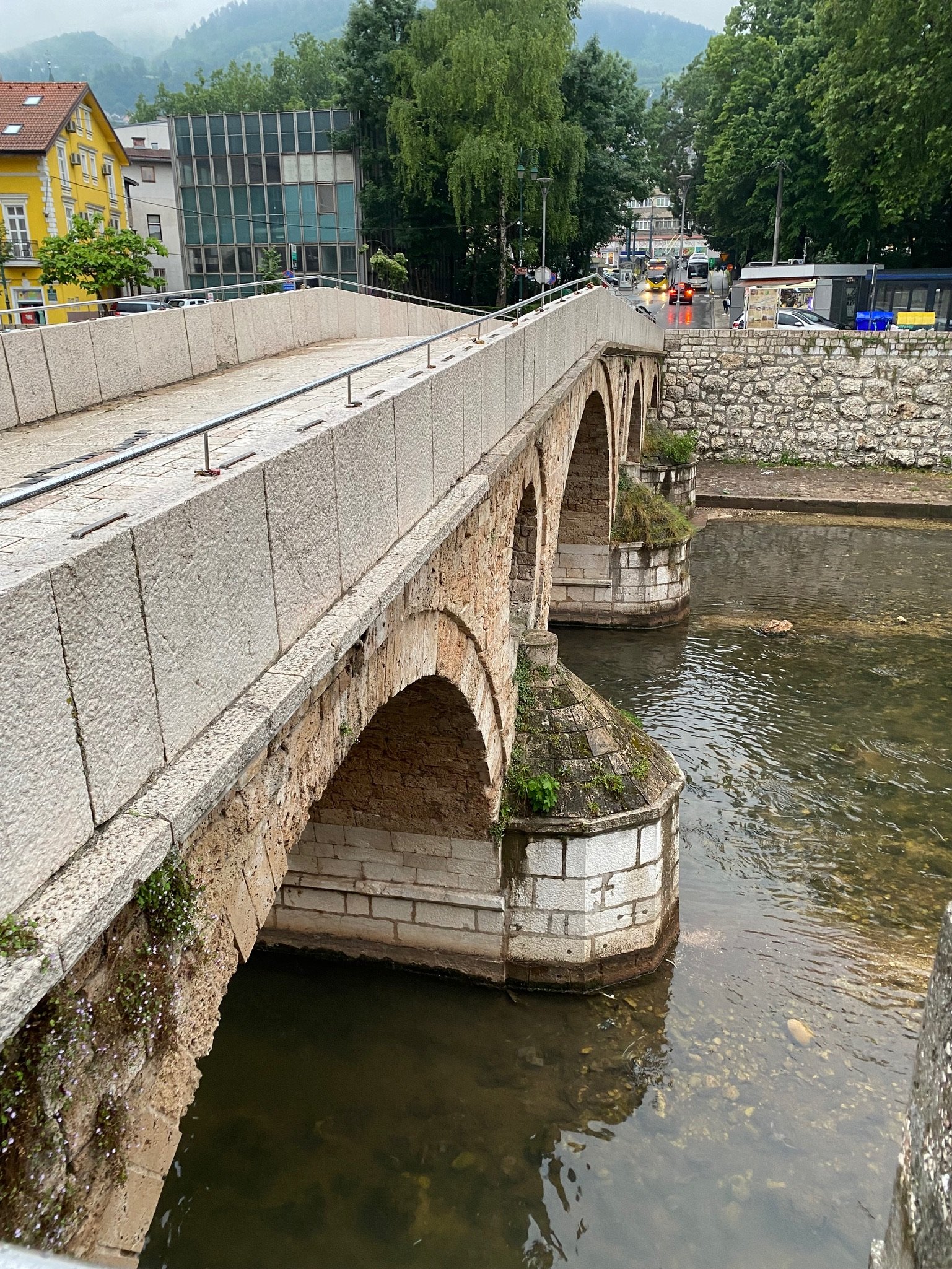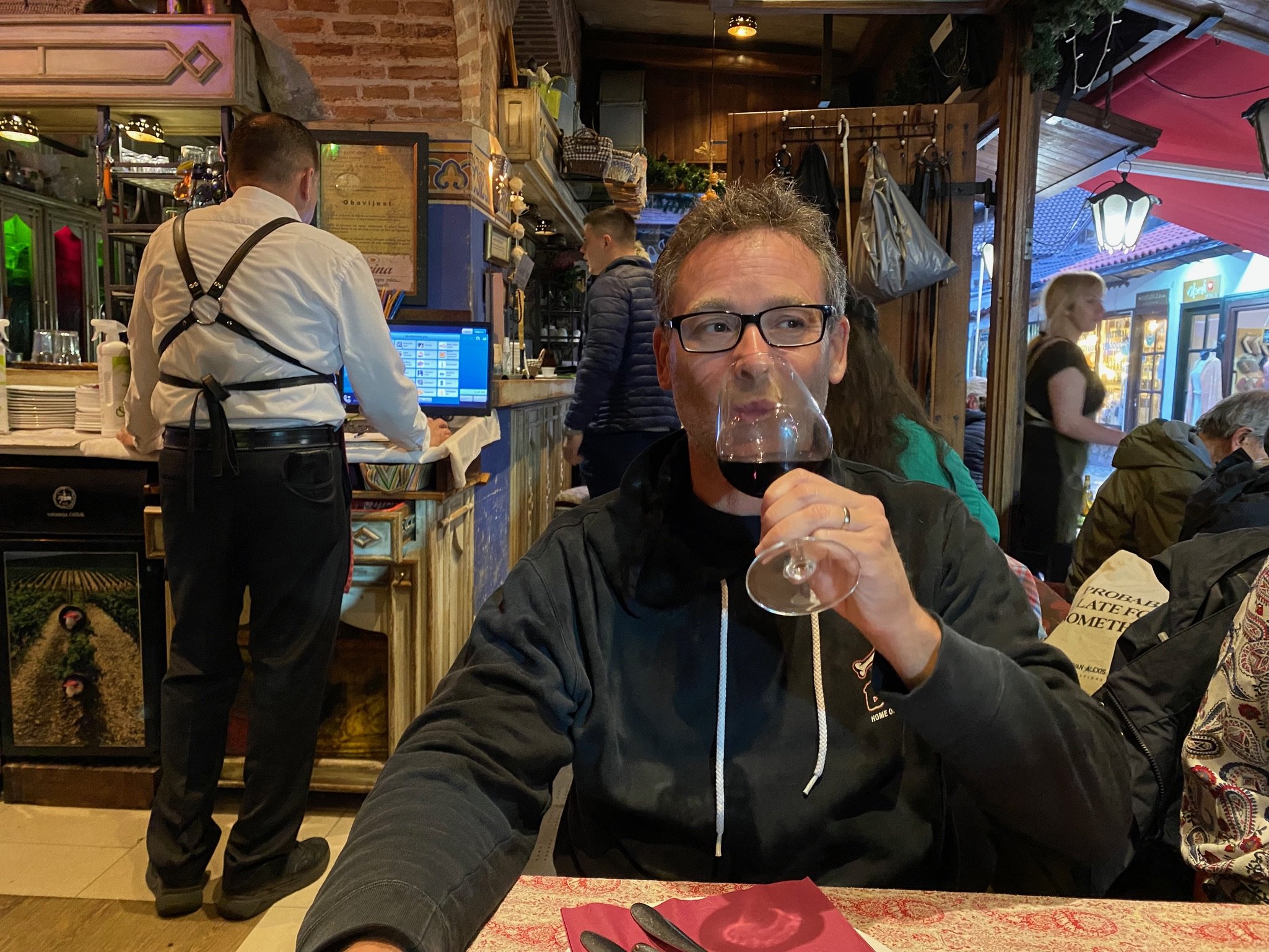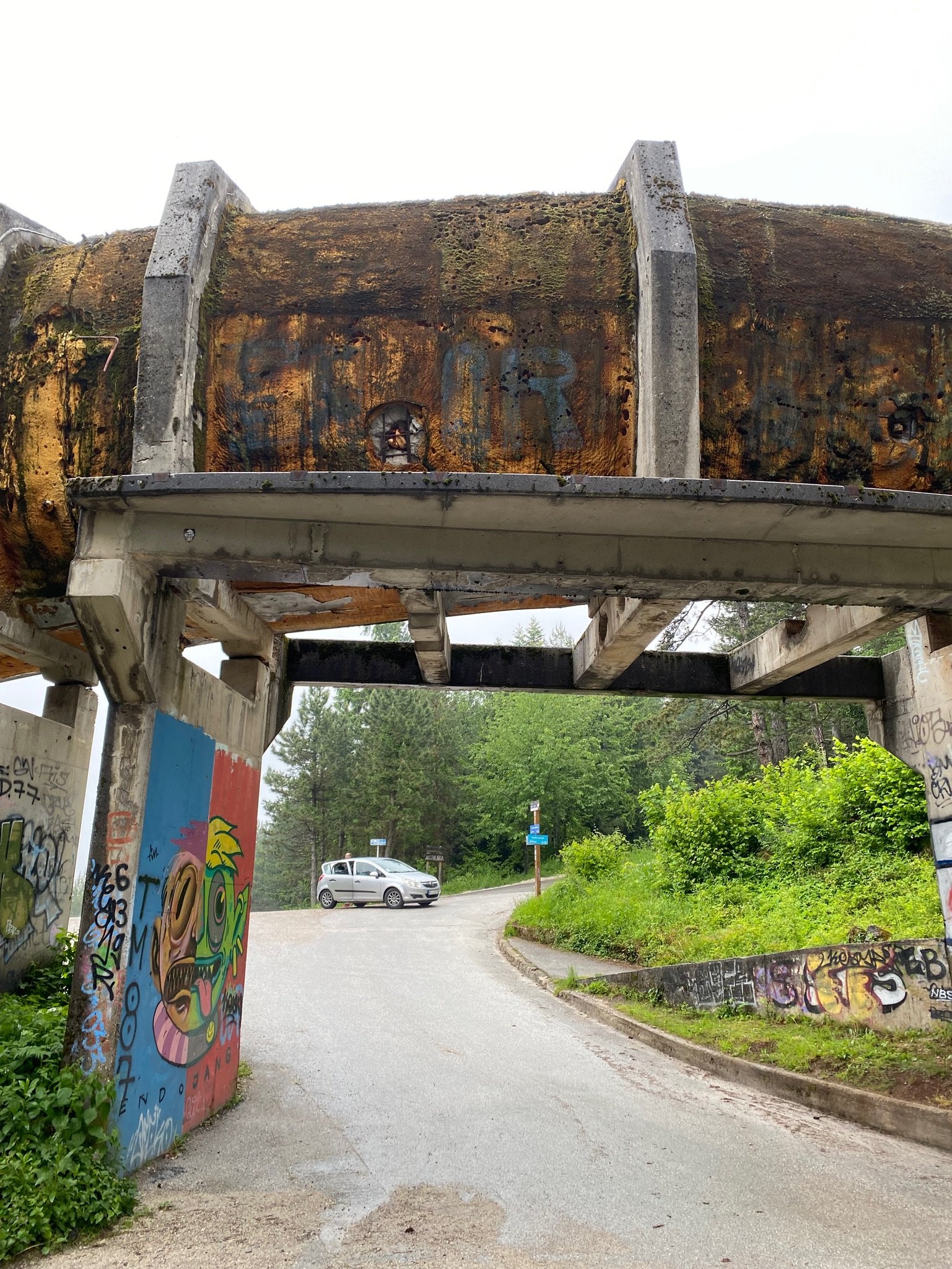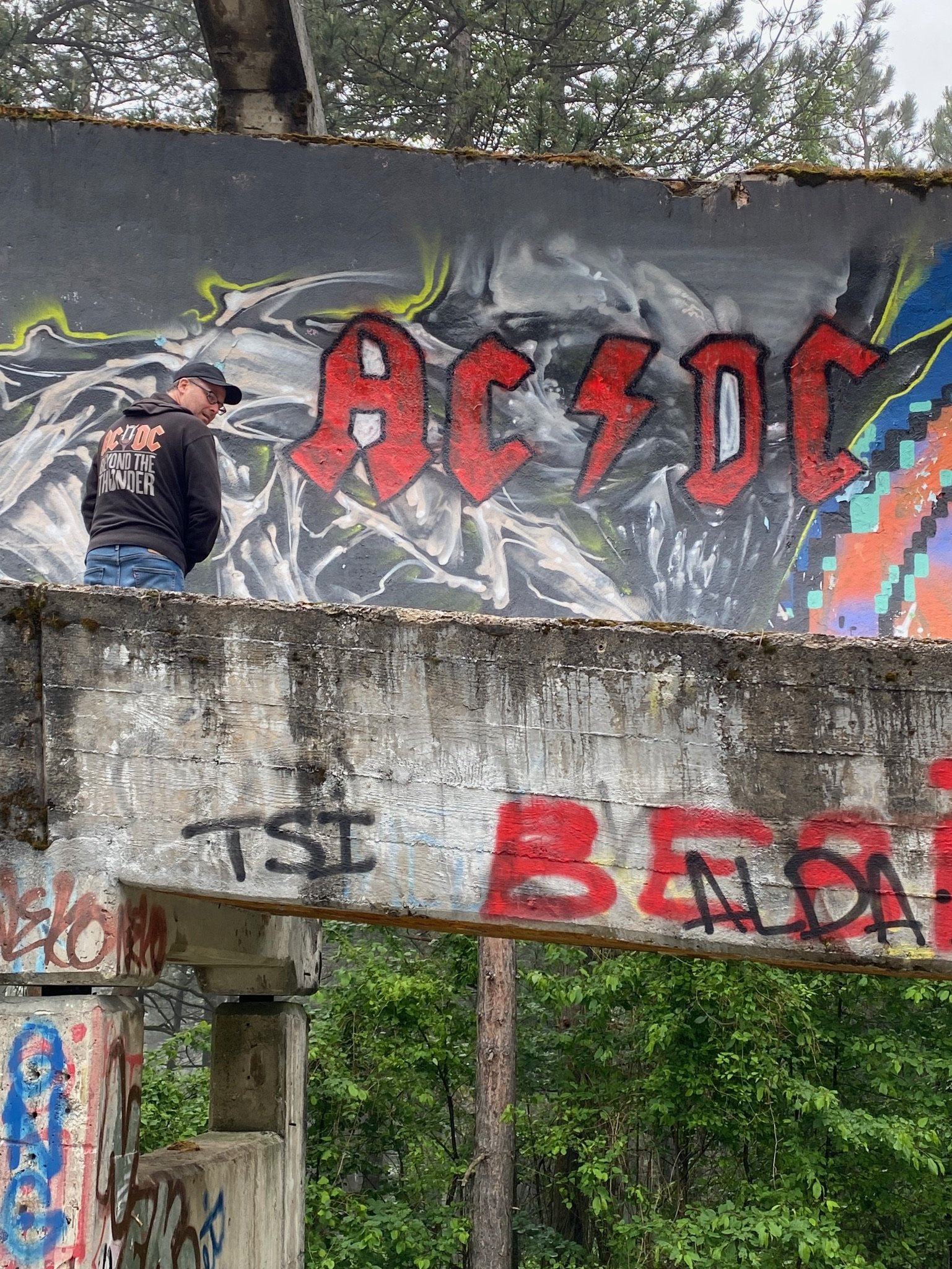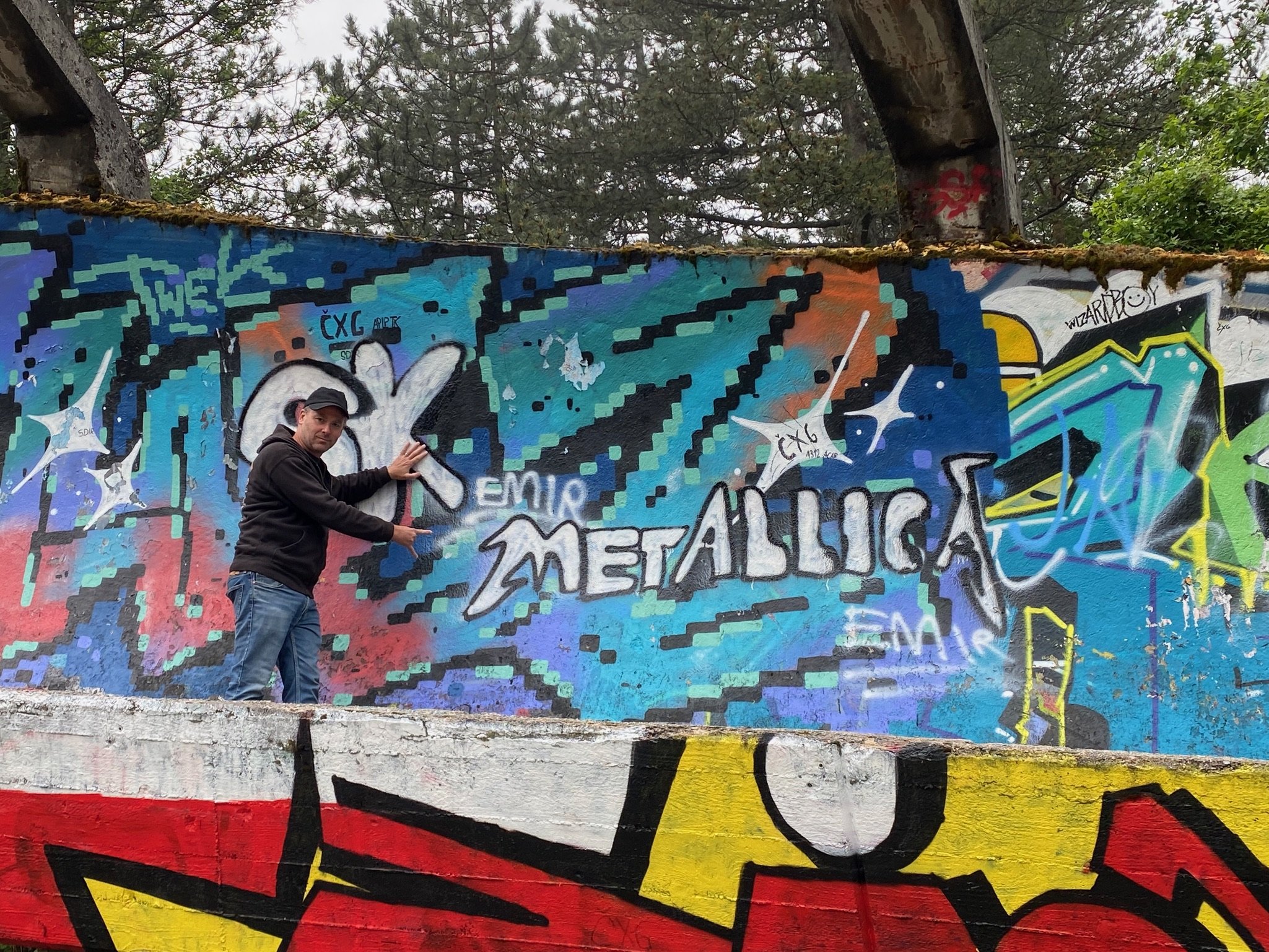Bullet holes, baklava, and Bruce Dickinson: 48 hours in Bosnia
When the war in the former Yugoslavia was raging during the 90’s, we were in college in the States. Bosnia, Serbia and Croatia were places that we heard about on the evening news, but probably couldn’t locate on a map. The war was an awful thing that we knew was happening, but, with typical American insularity, it didn’t affect us directly, so the average person (myself included) didn’t pay much attention to it, and certainly couldn’t explain it in great detail.
Now, almost 30 years after the Dayton Peace Accords were signed, we’ve spent the bulk of our year in Europe not only living in Croatia (thanks to their Digital Nomad Visa), but also had the chance to go on a quick weekend getaway to one of their neighboring countries.
We’ve seen and experienced so much during our year abroad, but I don’t think we were prepared for Bosnia and Herzegovina. We spent just two days there, but it affected us in ways that we’re still processing and that we won’t soon forget.
We decided to drive, since renting a car in Croatia is easy and cheap. It was a beautiful drive on new and well maintained highways through a picturesque landscape of mountains, rivers and pine trees. Rest areas with gas stations and coffee shops were plentiful, as were these cool land bridges built to make it easier and safer for wildlife to cross the highway:
Never saw any roadkill. Why don’t we have these in the U.S.?
Crossing the border into Bosnia was relatively quick and painless. With just a quick check of our ID’s and a stamp for the passports, we were on our way.
Our first stop was the historic town of Mostar, just two hours from our apartment in Split, Croatia. The Old City Center is the heart of Mostar, and its centerpiece is definitely the Stari Most (literally “Old Bridge”).
Stari Most and the Old City Center area of Mostar
Stari Most was built in the 16th century and spans the Neretva River from a hight of over 78 feet. It was destroyed during the war in 1993, but was rebuilt and reopened in 2004. It’s an amazing piece of architecture, and is often crowded with tourists.
View of Stari Most from one of the many outdoor cafes that line the river. Note the man in blue swim trunks collecting money for a dive.
Young men in Mostar have been diving off this bridge as a sort of rite of passage (and as a way to make a little money off the tourists) for decades. When enough people have gathered, they will pass the hat amongst the onlookers, pumping up the crowd and cajoling them to give more, teasing them as if they’re actually going to dive, only to stop short at the last second. When a diver is finally satisfied with the amount collected, they’ll step off the bridge and gracefully drop straight down into the river below.
Getting ready…
Not enough money yet…
Typical diving form (photo by https://unsplash.com/@darceybeau, since I was too damn slow to capture a dive in progress).
This was our first time visiting a city with a large Muslim population. There are many mosques in Mostar, and we were able to hear the hauntingly beautiful call to prayer as it was broadcast over loudspeakers perched on minarets. Visible from the bridge was the impressive Koski Mehmed Pasha Mosque, built in the early 1600’s.
Dome and minaret of the Koski Mehmed Pasha Mosque, as seen from Stari Most
The mosque was severely damaged in World War II and almost destroyed during the Bosnian War, but was renovated and opened to the public in 2004. For a small fee, you can step inside and have a look, and also climb the minaret for an impressive view of the bridge and the river. The interior is small but beautiful, and this was the first time any of us had been in a mosque.
Interior of the mosque
The area around Stari Most is the oldest part of Mostar and is known as Bazar Kujundžiluk, or the Old Bazaar. It’s an Ottoman-era marketplace, with cafes, restaurants, stalls and kiosks lining a car-free cobblestone street.
Bazar Kujundžiluk
Much like Paris, where you can buy just about anything with a picture of the Eiffel Tower on it, there are lots of kitschy novelties for sale emblazoned with the image of Stari Most. But there are also some amazing examples of traditional crafts available as well, such as textiles, rugs and jewelry:
Rugs and trinkets for sale in the Old Bazaar
…traditional coffee and tea sets:
Coffee and tea are a BIG deal in Bosnia.
…intricate art handcrafted by coppersmiths:
Coppersmithing has been a part of Bosnian culture since the 16th century.
…and artisan brass works:
Pens, keychains and grinders in brass and copper made from repurposed ammunition
There are also several art galleries and museums to visit, including one dedicated exclusively to Stari Most. However, with only a few hours to spend in Mostar, we only had time to visit one, and it had a profound effect on us.
The Museum Of War And Genocide Victims 1992 - 1995 was an overwhelmingly powerful and emotional experience. It tells the history of the war through stories of suffering from some of the victims. The displays included archival film footage of the destruction and many personal testimonies from people who lived through the atrocities. And the museum did not flinch in its description of those atrocities, especially the genocide and concentration camps. The bulk of the museum consists of personal items belonging to victims, some of which were exhumed from mass graves. A bloody t-shirt, a child’s comic book, a hemet with a bullet hole and hundreds of other similar items line the walls, each with a description of where they came from, who they belonged to, and what happened to that person during the war. The stories were heartbreaking and difficult to stomach at times, but for Americans like us who didn’t know the horrific details of the conflict, it provided some much-needed education and an eye-opening shift in perspective. It’s an absolute must-see if you’re ever in Mostar.
Though we were not prohibited from taking photos, it somehow felt like it would be disrespectful to do so. However, having just seen and walked on the beautiful Stari Most, I did snap one “photo of a photo” of the bridge as it looked after the bombardment in 1993:
Visiting the museum was the last thing we did in Mostar. It was a very quiet walk back to the car as we all silently tried to process what we had just seen.
Two hours later, we arrived in Bosnia and Herzegovina’s capital and largest city, the beautiful Sarajevo.
The city is sort of bowl shaped. Its historic Old Town section is at the bottom, and the other sections spread out from there and up onto the hillsides and mountains that surround it. Our Airbnb was up on one of those hillsides and, taking in the view of the city from above, we were able to see the mix of cultures and historical eras that are so unique to Sarajevo. Centuries old steeples, minarets and domes sit side by side with modern sky-scrapers, communist-era apartment blocks and old concrete structures that still bear the scars and bullet holes from the war in the 90’s. The two days we were there were cloudy and rainy, and the city was often shrouded in fog and mist, which only added to its mystique.
Panoramic view of the city from above
The Miljaka river runs through the city center, and there are over a dozen bridges that span it. One of the oldest and most well-known is the Latin Bridge:
The Latin Bridge, or Latinska ćuprija
Built in the 1500’s, it is most famous for its northern end, which was the site of the 1914 assassination of Archduke Franz Ferdinand, which led to the outbreak of World War I.
View of the assassination site from the bridge. The Archduke was shot when his driver mistakenly made a right hand turn onto Franz Josef Street. The assassin, Gavrilo Princip, fired the fatal shot from the right hand side of the street, just in front of the museum.
Walking across the bridge and continuing for a block or two brought us to the Stari Grad neighborhood, or “Old Town.” Much like the old bazar in Mostar, it’s a car-free cobblestone pedestrian zone lined with coffee houses, restaurants and shops. The Ottoman influence is strong, and the people were warm, welcoming and friendly, with a wickedly dry sense of humor. We poked our heads into a tiny jewelry store because we saw that there was a cat inside. The owner greeted us and invited us inside to pet the cat. She said, “You like cats? You come to my house. I have six at home. Why? Because a cat is better than any man!”
FACT: all the best jewelry stores have a resident cat.
Sweet shops abounded, and we sampled some amazing baklava (best I’ve ever had), and our friend Shona, who grew up in the U.K., was excited to purchase some Turkish delight. Now, if you’re like us, and you grew up in the U.S., you probably first learned about Turkish delight after reading The Lion, The Witch, And The Wardrobe. That book makes it sound amazing, right? Well, years later, I finally tried it for the first time in 2003 in Australia and, well, let’s just say I found the experience underwhelming. Not sure what I was expecting, but it was basically a chewy gum-drop type of candy (not unlike Chuckles or JuJuBees). I don’t know what Edmund was gushing about in that book, because the stuff I tried back then sucked! That being said, at the time, it was an impulse buy from an Australian convenience store that came in a wrapper like a Twix or Snickers bar. This was perhaps not the best way to experience Turkish delight for the first time. Fortunately, Shona’s version was hand-made, softer and much more flavorful, with a sprinkling of fine powdered sugar. After sampling her stash, I am now a proud member of Team Turkish Delight!
Sarajevo sweet shop with pyramids of Turkish delight and trays filled with the best baklava
After a delicious lunch in a small Turkish restaurant, we stopped at a coffee house and tried Bosnian coffee for the first time (although our Turkish waiter said with a smile, “Yes, they call it Bosnian coffee, but we showed them how to make it.”). Sipping Bosnian coffee is an experience unto itself, and there’s a sort of ritual to doing it properly that’s a bit like taking a shot of tequila; there is a specific order in which you’re supposed to do things.
The coffee is served on a tray, with six specific components: a small pitcher-like container of coffee called a džezva, a small ceramic cup to sip your coffee from called a fildžan, a small sugar pot containing large sugar cubes, a small bowl for a sweet treat (usually Turkish delight), a glass of water, and a small tea spoon with a long handle.
Typical Bosnian coffee setup
Here’s how you’re supposed to drink Bosnian coffee:
1) Take the spoon and scrape a little foam off the top of the coffee and drop it into your cup.
2) Very slowly pour some coffee into the cup.
3) Take a sugar cube and dunk half of it into the coffee.
4) Bite off half the sugar cube, hold it under your tongue and take a sip of coffee.
5) Savor the coffee/sugar flavor combo and swallow.
6) Take a sip of water to cleanse your mouth, then repeat steps 1-6 until your cup is empty.
7) Pour another cup and start the whole process over again until the coffee is gone.
8) Finish off with your delicious piece of Turkish delight.
Bosnian coffee is strong, dark and rich. If you’re a native New Englander like me, and your go-to order is usually a medium Dunkin’ with 2 creams and 2 sugars, you may want to add just a touch of milk. And for the Bosnians, it’s all about slowing down and taking some time to actually enjoy your coffee, so it’s meant to be sipped slowly over a long period of time with good friends and good conversation. Naturally, coffee “to go” is just not a thing here.
Later that night, we returned to Old Town for some dinner. We had no reservations, but there were usually always some tables available in any restaurant for us to walk in and sit at. However, with a large Muslim population, many of the restaurants in this particular area don’t serve alcohol, so it took us a few tries before we found a place where the food looked good and we could also have a glass of wine. We ended up at a pretty decent Italian place, then strolled around a bit to soak in some more of the Old Town vibe and take in some night time sites.
Not every restaurant in the Old Town serves alcohol, but his one certainly did!
One of the most impressive monuments was the Vječna Vatra, or Eternal Flame. It’s a memorial to the military and civilian victims of World War II (another reminder of the city’s long history of warfare). It was dedicated in 1946 on the one year anniversary of the liberation of Sarajevo after a four year occupation by the Nazis and what was then the fascist Independent State Of Croatia. We hadn’t really known about this monument, but we were happy to have stumbled upon it, especially at night, when it looked particularly striking.
A mother and son stop to admire the Eternal Flame
The next day, we embarked on what turned out to be the absolute highlight of our trip. It was a four hour tour all about the fall of Yugoslavia and the siege of Sarajevo. I was a little apprehensive when I heard about the length of the tour, thinking it was going to be waaaayyyyy too long. Thankfully, this was not the case. At no point did any of us find ourselves growing bored or glancing at our watches wondering when it was going to be over. We booked it through Meet Bosnia Tours, and we highly recommend them! Easy to book, easy to find, super nice English speaking staff, and a fantastic tour from start to finish.
Most of the credit for how much we enjoyed the tour should go to our guide, Ahmed. At 24 years old, he was obviously much younger than us. But he was a history student with extensive knowledge of the war and the history of Sarajevo who had grown up in the city. His father had served in the military during the siege while his mother worked as a journalist. Ahmed threw a lot of information at us, but presented it in such a way that it was easy to follow, and we never felt overwhelmed. He helped us to finally understand the causes of the war, what happened during the siege and the impact that it had on the people of Sarajevo. And though he was passionate, his presentation was neutral, factual, and often very funny, even though we were obviously dealing with some very serious subjects. Also, when we met him at the office on the morning of the tour, he was wearing a pretty sweet Led Zeppelin shirt, so I knew we would like him right away! Turns out, he was a metal fan too (more on that in a bit).
Me with Ahmed (left), our rock star tour guide. I want that Zeppelin shirt!
Some highlights from the tour:
A visit to the Yellow Fortress, built in the 1700’s and a defensive point high above the city where canons were placed. These days, it’s a popular spot for sunsets and stunning panoramic views.
Looking down on Sarajevo from the Yellow Fortress defensive point. Note the cemetary in the lower right corner with its distinctive white Muslim headstones.
A stop at the ruins of the old maternity hospital, with damage from the war still clearly visible. Ahmed told us his father spent his very first night as a soldier here.
Covered with bullet holes
A visit to the Tunnel Of Hope. It was built in 1993 while Sarajevo was under siege. The city was completely surrounded and cut off from the outside world, so the tunnel provided a link between Sarajevo and an area just beyond the airport which was controlled by the UN. Food, supplies, weapons, ammunition and humanitarian aid were brought into the city though the tunnel, and it also provided a way for people to get out of Sarajevo.
The entrance was in the basement of a house near the airport owned by the Kolar family. Today, the house and a portion of the tunnel have been preserved as a museum.
Entrance to the Tunnel of Hope museum. Again, note the bullet holes.
Here’s a quick video courtesy of the folks at Meet Bosnia Tours (seriously, book your tours with them!) showing a portion of the tunnel and explaining a little bit about what it was used for:
There were also many displays and photographs at the museum explaining what life was like in Sarajevo during the siege, and how the citizens tried to carry on with some sense of normalcy despite their extraordinary circumstances. There were stories and photos about film festivals, beauty pageants, comedy television productions and other events all held in the middle of an active warzone. It was among these displays that I spied a curious photo: kids at a rock concert in Sarajevo holding up an Iron Maiden banner? In the midst of all the devastation and chaos? How? Why?
Me and my big dumb face throwing the horns for the most intriguing photo at the tunnel museum
This was when we learned that our guide Ahmed was a bit of a metal-head. He told us the story of a historic concert that took place in the city during the siege in 1994. Two British UN workers came up with the idea to put on a rock show. They first approached the Rolling Stones, who turned them down. Motorhead was also asked, with frontman Lemmy actually agreeing to play, only to have his management refuse just weeks before the proposed date. Metallica was also asked to perform, but they too turned down the gig. Eventually, the offer came to Bruce Dickinson, lead singer for Iron Maiden, who was then touring as a solo artist after having quit the band the previous year. To everyone’s surprise, Bruce said, “Sure! Why not?” The now legendary show took place on December 14th, 1994. Writing about it in his 2017 autobiography, Bruce said, “We weren't protected, there was no plan and the bullets were real, but…we went anyway…It changed the way I viewed life, death and other human beings."
The remarkable story of how Bruce and his band were essentially smuggled into Sarajevo for the concert and the lasting impact that the show had on the people who were there can be seen in the phenomenal documentary Scream For Me Sarajevo!, which Ahmed enthusiastically recommended to us (and which we immediately rented and streamed after returning to our AirBnB later that day). Check out the trailer:
As we drove around Sarajevo from one tour stop to the next, Ahmed pointed out other important sites such as the infamous area known as “Sniper Alley,” the Hotel Holiday where most of the foreign war correspondents stayed, the City Hall that was shelled in 1992, causing the complete destruction of its library, and the Zetra Olympic Hall, used as a venue for the ‘84 winter Olympics and as a morgue and staging area during the Bosnian War.
He also told us the story of the Vrbanja Bridge, which is now known as the “Suada and Olga bridge” named after Suada Dilberović and Olga Sučić, the first victims shot at the beginning of the siege. It is also called “The Romeo And Juliet Bridge,” a name inspired by the true story of Admira Ismic and Bosko Brkic, a Bosnian Muslim and an Orthodox Christian Serb. Just 25 years old and childhood sweethearts, the two lovers were planning to flee the city, only to be killed by sniper fire while trying to cross the bridge in 1993. Bosko was killed instantly. Admira, shot second but still alive, crawled over to her boyfriend, embraced him, and died. Their bodies lay in that same position on the bridge for seven days. The two are now buried together in Lion Cemetery in east Sarajevo. In 2017, NBC news aired a brief story about the couple:
Our final stop on the Fall of Yugoslavia Tour was one of the most memorable. We drove up Trebević Mountain to visit the abandoned bobsled and luge tracks constructed for the 1984 Winter Olympics. During the siege of Sarajevo, the tracks were used as an artillery position by Serbian forces. These days, though the tracks have long been abandoned, they remain a popular tourist attraction, and, thanks to their peaceful forested location, a popular spot for local families to take a stroll or do some biking.
Seeing the tracks was surreal, especially since I’m old enough to have watched some of the ‘84 games on TV. They’re now covered with graffiti, and you can still see bullet holes and defensive holes that were drilled by the Serbs during the conflict. It was eerily quiet and a bit spooky, but very moving as well. Definitely one of the highlights of a truly unforgettable tour.
Me and the Mrs on the tracks
Bullet holes
Showing off my AC/DC Beyond The Thunder Podcast sweatshirt next to the AC/DC graffiti. Definitely not peeing.
Master of sledding! Kinda’ shocked that there wasn’t some Iron Maiden graffiti as well.
At the end of the tour, we were driven back to the Meet Bosnia Tours office, and I had a chance to chat with Ahmed. I asked him about Bosnian metal, and he recommended two bands. The first are considered pioneers of Bosnian/Yugoslavian metal and hard rock. They’re called Divlje Jagode, which translates into English as “Wild Strawberries.” Sort of an odd name for a heavy metal band, but these guys are apparently pretty iconic in this region. Their self-titled debut album was released in 1978, and it sorta’ sounds like a Sabbath/70’s Deep Purple hybrid (with non-English lyrics of course).
Second album Stakleni Hotel ("Glass Hotel") was released in 1980, but it was the third album, 1983’s Motori (“Motorcycles”) that proved to be the band’s big breakthrough. The title track is considered by some to be their biggest and best-known song.
At this point, after 40+ years and dozens of line-up changes, Divlje Jagode are still popular, still well respected, and still active. Their last full-length studio album Jukebox was released in 2020, and they just released a new single called "Ukrala Je Svjetlost Istoka" this year.
The second band Ahmed recommended (“…that is, if you don’t mind metal that’s a bit more on the extreme side,” he said with a smile) was Silent Kingdom. Formed in 1999 and still active today, they seem to have experimented with a number of different styles throughout their career, including black metal, progressive black metal, melodic death metal, folk metal, and prog metal. Ahmed said he thinks they pretty much abandoned metal altogether in favor of a straight-up prog rock sound on their last album The Shadowless Queen, so he suggested I try their Chronicle 1999 - 2019 (20 Years And Counting) collection instead. It’s a six CD box set containing their first six full-length albums, and it’s good stuff! Fans of the 90’s Gothenburg sound will find a lot to like here, especially fans of early Dark Tranquility and In Flames. Mid-period Death and the proggy death metal of Opeth seem to be influences on Silent Kingdom as well. Hell, even fans of Dream Theater, Queensryche and Rush might dig this (as long as they can get past the vocals). Six albums worth of material is a lot to digest, so take your time, dig in and explore. Thanks, Ahmed!
And while we’re on the subject of Bosnia from a heavy metal perspective, its worth mentioning one particular album by the band Savatage. If you’re not familiar with them, no, Savatage is not a Bosnian group; they’re from Florida.
In 1995, Savatage released a concept album called Dead Winter Dead. The setting: Sarajevo during the war in the 90’s, which was still on-going at the time the album was written and recorded. The main characters include a Serbian boy, a Bosniak girl, an old man, and a stone gargoyle who has watched over the city for 1000 years from his perch high atop an old church, trying to understand the human concepts of laughter and tears.
Oh, and I can all but guarantee that you know at least one song from this album, even if you’re just hearing about it for the first time, or you’re not a metal fan and you’ve never even heard of Savatage. In fact, I’ll bet you hear this song every December.
It’s called “Christmas Eve (Sarajevo 12/24).”
If that title sounds a little familiar, it’s because the song became sort of a surprise hit, and it gets regular holiday airings on rock radio around Christmastime every year. It’s an instrumental track featuring the band plus an orchestra and a lone cello player, and it incorporates rocked up melodies from “Carol Of The Bells” and “God Rest Ye Merry Gentlemen.”
When Savatage released “Christmas Eve (Sarajevo 12/24)” as a single, it actually made it onto the Billoboard Top 40 charts, peaking at number 34 in 1996. When the song was re-released under the name Trans-Siberian Orchestra, it charted again, and is now a bona-fide holiday staple, having sold over 1,300,000 copies. Trans-Siberian Orchestra started off as a Savatage side project, but the’ve now released seven albums, tour annually around the holidays and have reached a level of success never dreamed of by Savatage. In fact, TSO has become so successful, they’re now the full-time focus of Savatage founder Jon Oliva.
Admittedly, this type of theatrical, over-the-top “Broadway metal” has never really been my cup of tea, and I honestly didn’t pay much attention to Dead Winter Dead when it first came out back in the day. Now, having visited Sarajevo and learned about the devastation and the atrocities, and having walked the streets where so much tragedy occurred, I’ve revisited it with fresh ears and a fresh perspective since our trip.
It’s now been well over a month since we took that trip, but not a day has gone by where I haven’t thought about it or been reminded of it in some small way. I reflect on the divisions in my own country, and how easily it could all spiral out of control. I think about the peace in Sarajevo, however fragile it may be, with Orthodox churches, synagogues, and mosques all sharing the same block.
And I think about the power of music; to heal, to unify, to inspire. I think about the Bruce Dickinson show, and how it wasn’t just any kind of concert that brought a night of joy to an otherwise hopeless situation… it was a metal concert. Those that think heavy metal is only negative, violent or without artistic merit couldn’t be more wrong. Just ask those kids who were at that show 30 years ago. Watch the documentary and witness for yourself how these kids (now adults) talk about the show through tears of sorrow mixed with joy. Listen as they explain about the magic created that night by a heavy metal band. How, for just a brief moment, they could forget about the misery and simply live in the moment. How thankful they were that one of their favorite artists hadn’t forgotten about them. How they knew that happiness and good times weren’t gone forever, that they were still possible, and they would return, even if it took years.
You may not like heavy metal, and that’s OK. It’s not for everyone. But its power and impact are undeniable.
Sarajevo knows.
















